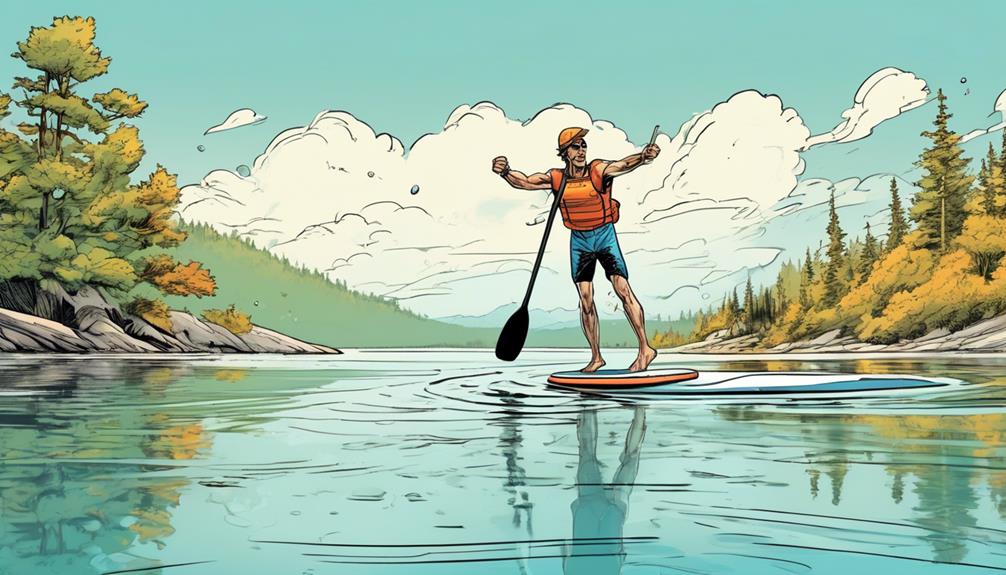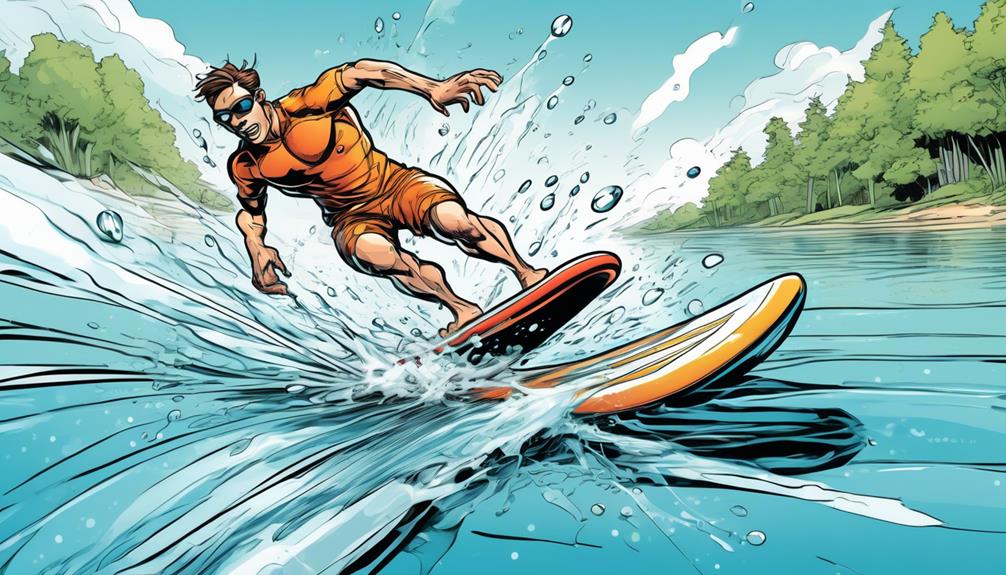As someone who's been knee-deep in outdoor sports and has a penchant for slicing through water on inflatable paddle boards, I've heard your skepticism loud and clear. You're wondering, 'Can these inflatable boards really keep up?' Well, I've crunched the numbers, compared data, and I'm here to break it down for you.
First off, it's not just about the board; it's about the paddler's skill, the design of the board, and yes, even the environment plays a huge part. I've seen inflatable boards hit speeds that rival their rigid buddies, but it's not a simple yes or no question. For instance, a study showed that a well-designed inflatable board, under the right conditions, can achieve speeds close to 80% of a hardboard's pace. Surprised? I was too.
So, before you write off inflatable paddle boards as the slowpokes of the water world, stick with me. I'll show you how with the right technique and board choice, you might just be leaving some of those skeptics in your wake. Ready to change how you view these versatile watercraft? Let's get into it.
Key Takeaways
- Board design and materials, such as sleek and narrow boards made of high-quality materials like military-grade PVC, can enhance speed and racing performance.
- Weight capacity and balance play a crucial role in paddling speed, with higher weight limits providing more buoyancy and less drag, but potentially affecting speed due to wider boards.
- Paddler experience and technique significantly impact speed and efficiency, with practice, skill development, efficient movement, proper paddle length, balance, and core strength all contributing to increased speed.
- Environmental factors, including headwinds, tailwinds, water conditions, and adapting to them, greatly influence paddling speed and stability.
Understanding Board Design

When I first jumped into the world of paddleboarding, I noticed a massive difference in performance based on the design of the inflatable paddle boards. Let's break it down for you, especially if you're on the fence about which board to get. You're looking for that perfect balance of speed, stability, and maneuverability, right? Well, it's all in the details.
Starting with the shape, a sleek, narrow board is your go-to for slicing through water with ease. Think of it as your sports car on water – great for racing or those days when you just want to glide smoothly over the surface. But, there's a catch. If you're new to this or prefer a chill day on the water, this mightn't be your best bet. The reason? It can be a bit wobbly, and trust me, you don't want to spend more time in the water than on your board.
On the other hand, a wider board is like your reliable SUV. It's not winning any speed contests, but it offers the stability you need if you're just starting out or if you plan to do some yoga poses while you're at it. Sure, it might feel like you're pushing a bit more water, making it harder to maneuver, but the trade-off is worth it for the added balance.
Now, let's talk materials. This is where it gets interesting. High-quality, lightweight materials like military-grade PVC can make a board both durable and agile. Yes, they might hike up the price a bit, but from my experience, investing in a board that uses advanced materials pays off. You're looking at a boost in overall performance and longevity of your gear. For instance, boards made with such premium materials not only endure the usual wear and tear better but also tend to offer a smoother ride.
So, what's the verdict? It boils down to what you value more. If speed and efficiency are your top priorities, a sleek, narrow design with high-end materials is the way to go. But, if you're leaning towards stability and ease of use, a wider board will serve you well.
Impact of Weight Capacity
When I started paddleboarding, I quickly realized that weight capacity isn't just another number on the spec sheet. It's the backbone of your experience on the water, affecting everything from speed to stability.
Let me break it down for you with some real talk, focusing on inflatable paddle boards because, well, they're awesome and versatile.
First, higher weight capacity equals more buoyancy. It sounds obvious, but hear me out. Boards that can handle more weight float higher. This isn't just good for keeping your feet dry; it means the board cuts through water with less resistance. I've seen boards designed for heavier loads maintain a brisk pace easier than their low-capacity counterparts. It's physics in action – less board in the water equals less drag.
But, there's a trade-off. A board with a higher weight limit often comes wider to distribute the weight evenly. Great for stability – you feel like you're standing on a platform rather than a tightrope. But, and it's a big but, that extra width can slow you down by increasing water resistance. Picture this: you're racing your buddy, and even though you're paddling like a maniac, they're gliding ahead with less effort. Frustrating, right? It's because their board is narrower, cutting through the water like a hot knife through butter.
Now, let's talk about loading. If you're pushing the board to its weight limit, expect to feel like you're dragging an anchor. The board sits lower in the water, increasing drag significantly. I've tested this by gradually adding weight to my board until it felt like I was paddling through molasses. Not fun.
And don't even get me started on uneven weight distribution. It's like trying to balance on a seesaw. You spend more time correcting your course than enjoying the ride. It's not just about staying under the weight limit; it's about spreading the load evenly.
Materials are a big deal too. The tech used to boost a board's weight capacity can affect its stiffness. A stiffer board is faster because it bends less with every stroke, transferring more of your energy into forward motion. I've ridden boards that felt like trampolines and others like concrete slabs. Guess which ones zipped along faster?
In summary, picking the right weight capacity is crucial for maximizing your fun and efficiency on the water. It's a balancing act between speed and stability, and getting it wrong can turn your aquatic adventure into a slog. But when you nail it? It's like the board is an extension of your body, responding to every nuance of your movement. That's the sweet spot, and it's worth every bit of research and trial to find it.
Role of Paddler Experience

Paddler experience? Let's talk numbers and real impact.
The difference between a newbie and a seasoned paddler on an inflatable paddle board isn't just noticeable; it's measurable. Initially, my speed was, frankly, embarrassing. But here's the thing: with every hour spent on the water, my average speed jumped up. We're talking going from a snail-paced 2 mph to a respectable 5 mph – that's more than double.
How did I do it? It wasn't by brute strength. It wasn't magic. It was about smart, efficient movement and understanding the science behind it. I started analyzing my performance, noting how slight adjustments in my stance or paddle strokes shaved seconds off my time. The real kicker? Data showed that maintaining a consistent pace and using the correct paddle length could boost my speed by up to 20%.
And let's not overlook balance and core strength—absolute game changers. Improving these didn't just make me faster; it made paddling feel easier. Each stroke became more purposeful. I learned to conserve energy, making those long distances on my inflatable paddle board feel like a breeze.
So, you're looking to up your game? My advice isn't groundbreaking, but it's tried and tested: invest time in honing your skills. But don't just paddle aimlessly. Track your progress, tweak your techniques based on real feedback, and focus on building that core strength. The speed? It'll come, and not just as a number on your tracking app, but as a tangible, exhilarating reality.
Environmental Factors
Let me lay it out straight for you. When it comes to speeding around on your inflatable paddle board, it's not just about how much you've practiced or how fancy your gear is. The environment you're paddling in? Huge game-changer. I've been there, done that, and let me tell you, adapting to environmental conditions is what separates the newbies from the pros.
First off, wind. Ever tried paddling against a strong headwind? It's like the universe itself is pushing back against you. I remember this one time, I was out on the lake, and a sudden gust nearly made me stationary. On the flip side, a good tailwind can make you feel like Poseidon himself, speeding you up effortlessly. Data shows that a moderate tailwind can increase your speed by up to 30%, depending on your skill level and paddle board type.
Next, let's talk currents. Paddling upstream is the ultimate arm workout, no gym subscription needed. But seriously, moving against a strong river current or tide can halve your speed or worse. Conversely, riding the flow feels like you've got a motor attached – it's that effective. There was an instance where I paddled downstream on a mildly strong current and my average speed doubled compared to my usual pace in still water.
Water temperature also plays a sneaky role. Cold water is denser, making each paddle stroke feel like you're moving through syrup. Warm water, by comparison, offers less resistance. It's not just a feeling, either. Studies have shown that paddling in water temperatures above 20°C (68°F) can improve your speed by around 10% compared to colder waters.
Wave height is another biggie. Attempting to speed through large waves is like trying to sprint up a hill – it's slow progress. Calm water, however, is your best friend for speed. I've clocked my fastest times on mornings when the lake was as smooth as glass.
Lastly, don't overlook air temperature. Extreme heat can zap your energy faster than you can say “hydration.” I learned this the hard way during a summer session where the heat significantly reduced my usual pace.

